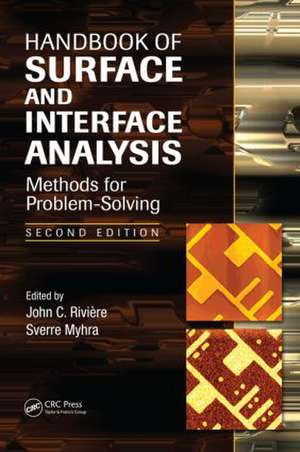Handbook of Surface and Interface Analysis: Methods for Problem-Solving, Second Edition
Editat de John C. Riviere, Sverre Myhraen Limba Engleză Hardback – 24 iun 2009
Major instrumental assets are generally funded and maintained as central facilities to help potential users make informed decisions about their appropriate use in solving analytical problem(s). Building on the popular first edition, this long-awaited second edition was motivated by the increasingly common industry view that it is more cost-effective to contract out analytical services than to maintain in-house facilities. Guided by that trend, this book focuses on developing strategic thinking for those who decide which facilities to access and where to subcontract analytical work. It covers most of the major tactical issues that are relevant at the location in which data are being produced.
New Information in this Second Edition Includes:
- Electron-optical imaging techniques and associated analytical methods
- Techniques based on synchrotron sources
- Convenient and versatile scanning probe group methods
- Scanning tunneling microscopy, biocompatible materials, and nano-structured materials
| Toate formatele și edițiile | Preț | Express |
|---|---|---|
| Paperback (1) | 568.28 lei 6-8 săpt. | |
| CRC Press – 14 iun 2017 | 568.28 lei 6-8 săpt. | |
| Hardback (1) | 1415.38 lei 6-8 săpt. | |
| CRC Press – 24 iun 2009 | 1415.38 lei 6-8 săpt. |
Preț: 1415.38 lei
Preț vechi: 1726.07 lei
-18% Nou
Puncte Express: 2123
Preț estimativ în valută:
270.87€ • 281.75$ • 223.62£
270.87€ • 281.75$ • 223.62£
Carte tipărită la comandă
Livrare economică 14-28 aprilie
Preluare comenzi: 021 569.72.76
Specificații
ISBN-13: 9780849375583
ISBN-10: 0849375584
Pagini: 680
Ilustrații: 8 page color insert with 12 images; 200+ equations; 42 Tables, black and white; 402 Illustrations, black and white
Dimensiuni: 178 x 254 x 36 mm
Greutate: 1.43 kg
Ediția:2nd edition
Editura: CRC Press
Colecția CRC Press
Locul publicării:Boca Raton, United States
ISBN-10: 0849375584
Pagini: 680
Ilustrații: 8 page color insert with 12 images; 200+ equations; 42 Tables, black and white; 402 Illustrations, black and white
Dimensiuni: 178 x 254 x 36 mm
Greutate: 1.43 kg
Ediția:2nd edition
Editura: CRC Press
Colecția CRC Press
Locul publicării:Boca Raton, United States
Public țintă
ProfessionalCuprins
Introduction. Elements of Problem-Solving/Materials Characterization. How to Use This Book. Spectroscopic Techniques. Compositional Analysis by AES and XPS. Ion Beam Techniques. In-Depth Analysis. Surface and Interface Analysis by HRTEM and XTEM. Synchrotron-based Techniques. Scanning Force Microscopy. Scanning Tunneling Microscopy. Metallurgy. Minerals, Ceramics, and Glasses. Composites. Corrosion. Tribology. Catalysts. Adhesion. Biocompatible Materials. Nano-structured Materials.
Recenzii
This handbook on surface and interface analysis can help to create that knowledgeable person … sufficient in-depth technical information to satisfy those who want to know the details … Material scientists, engineers, materials researchers, or anyone who needs information about a material obtained using surface analysis methods will find this handbook an excellent resource for determining the best approach and the right techniques to use.
—IEEE Electrical Insulation Magazine, Vol. 26, No. 3, May-June 2010
—IEEE Electrical Insulation Magazine, Vol. 26, No. 3, May-June 2010
Descriere
The Handbook of Surface and Interface Analysis: Methods for Problem-Solving describes the physical basis and technical implementation of the most commonly used techniques for materials characterization. Providing an overview of the benefits and limitations for each methodology, this second edition features five brand new chapters that address surface and interface analysis by HRTEM and XTEM, synchrotron-based techniques, scanning tunneling microscopy, biocompatible materials, and nano-structured materials. This volume combines the expertise from a distinguished group of scientists into a comprehensive, integrated source of information on the characterization methods considered crucial in this field.



















